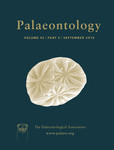Reg. Charity No. 1168330

Organisms in possession of a frondose body plan are amongst the oldest and most enigmatic members of the soft‐bodied Ediacaran macrobiota. Appraisal of specimens from the late Ediacaran Ediacara Member of South Australia reveals that the frondose taxon Arborea arborea probably possessed a fluid‐filled holdfast disc, the size and form of which could vary within populations. Mouldic preservation of internal anatomical features provides evidence for tissue differentiation, and for bundles of tubular structures within the stalk of the organism. These structures connect in a fascicled arrangement to individual lateral branches, before dividing further into individual units housed on those branches. The observed fascicled branching arrangement, which seemingly connects individual units to the main body of the organism, is consistent with a biologically modular construction for Arborea, and raises the possibility of a colonial organization. In conjunction with morphological characters previously recognized by other authors, including apical‐basal and front‐back differentiation, we propose that to the exclusion of all alternative known possibilities, Arborea can be resolved as a total group eumetazoan.
AcknowledgementsThe authors express their sincere gratitude to Mary‐Anne Binnie, Curator of Palaeontology at the South Australia Museum, for assistance in accessing the collections, and P. C. J. Donoghue and P. R. Wilby for fruitful discussion. L. Reid, F. Coutts, M. Fuller, D. Rice, C. Armstrong, F. Peddie, J. Perry, J. Bain, D. Reid and M. Ellis contributed to specimen collection. J. Hoyal‐Cuthill and another, anonymous, reviewer are thanked for their comments on earlier versions of this manuscript. This work was funded by the Natural Environment Research Council (GW4 DTP Studentship NE/L002434/1 to FSD, and Independent Research Fellowship NE/L011409/2 to AGL), and an Australian Research Council Discovery Grant (DP0453393) to JGG.